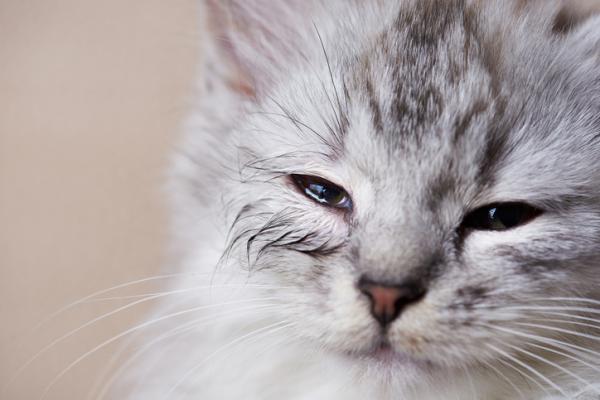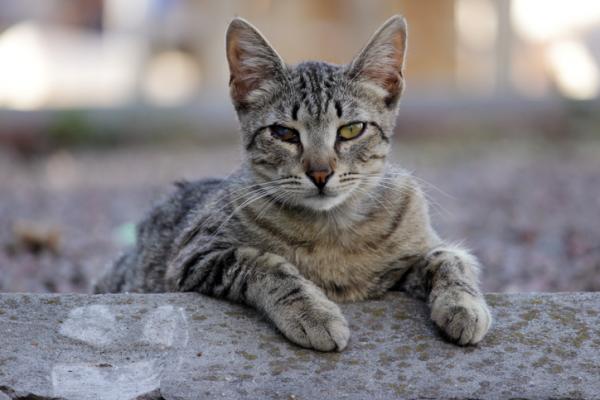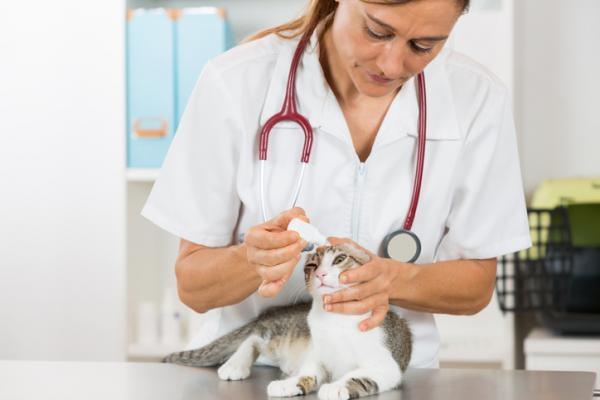Feline chlamydiosis – infection, symptoms and treatment

La feline chlamydiosis is a bacterial disease highly contagious, which mainly affects the eyes and the upper respiratory tract, although the causative bacteria can also lodge in the genitalia of cats. The pathology is more frequent among young street felines or those that live in groups, but can take on mininels of all ages, whether mestizo or of defined race.
If you recently adopted a beautiful pussycat, it is very important that you go to your trusted veterinarian to verify your health status and rule out possible diseases that threaten your well-being. And in this article, you will be able to know the main forms of contagion, causes and symptoms of feline chlamydiosis.
Causes and contagion of feline chlamydiosis
Feline chlamydiosis, also called feline chlamydia, is caused by a type of gram-negative bacteria called Chlamydophila felis. Currently, it is estimated that close to 30% of diagnoses of feline conjunctivitis are related to chlamydiosis. In addition, it was recognized that bacteria Chlamydophila felis usually act in association with feline calicivirus and rhinotracheitis virus.
The bacteria Chlamydophilas they can remain dormant in the environment, but they need a host to reproduce. That is why they enter the feline organism, where they find high availability of food and a safe environment. When they enter the body of the cat, its incubation period goes from 3 to 10 days.
On the other hand, the form of contagion is given from direct contact with secretions nasal and ocular of infected cats. Therefore, cats that live in groups are especially vulnerable to this pathology.
Formerly, chlamydiosis was known as “feline pneumonitis”, but the nomenclature was not very accurate, since these bacteria hardly reach the lungs. In general, they are concentrated in the eyes and in the upper respiratory tract, causing constant conjunctivitis and possible rhinitis.
Does chlamydia spread from cats to humans?
Chlamydiosis can not be contagious to humans by infected cats, but transmission is very easy among cats. That is why we insist on caution and go to the veterinarian before the first symptom, especially if we just rescue a stray cat, our cat has escaped or has been in contact with sick cats.
Symptoms of feline chlamydiosis
The first visible sign of feline chlamydiosis is a frequent aqueous discharge that can appear in one or both eyes. In general, the eyeball of affected cats has excessive moisture, making it water constantly. In many cases, they are also observed redness and inflammation of the third eyelid.
If the disease is not treated quickly, the watery secretion becomes increasingly viscous and becomes purulent (typical green color of pus). In this stage, the cat becomes vulnerable to the formation of ulcers around the eyes and in the corneas, in addition to conjunctive edema. It is also common fever, fatigue, loss of appetite and weight.
In more advanced cases, the respiratory system may be compromised. The affected feline can present constant runny nose and sneezing, which are usually caused by a picture of rhinitis. However, infection rarely reaches the lungs, lung lesions due to chlamydiosis being very rare.

Treatment for feline chlamydiosis
When observing any of the previous symptoms in your feline, it is essential to go quickly to the veterinarian to show you how to treat feline chlamydia. In the clinic, the professional will perform the clinical tests and complementary studies necessary to analyze the health of your pussycat and recognize possible pathologies. If the diagnosis of feline chlamydiosis is confirmed, the treatment will depend on the state of health and the evolution of the pathology in each feline.
In general, the Antibiotics are essential to contain reproduction and fight bacteria Chlamydophila felis. They can be prescribed orally (medications), intravenously or by means of eye drops (eye drops). Remember that antibiotics should always be prescribed by a medical professional. Self-medication is very dangerous and increases the resistance of bacteria, making it difficult to treat Clamydophila felis.
Even taking antibiotics, affected cats may have sticky or dark discharge for days and even weeks. Therefore, it will be important that clean your eyes and nose daily of your pussycat until the secretion disappears completely. The veterinarian can indicate some specific wipes or just a clean gauze and lightly moistened with saline or warm water.
During treatment, it is essential that the affected cat is separated from the other felines to avoid new infections. It will also be necessary to reinforce the hygiene of the home and disinfect the environment and the objects used by the felines. Remember that bacteria can remain latent in accessories, toys, sandboxes, scrapers, etc. Beware of traditional cleaning products, because the chemicals in their formula can poison cats and irritate their mucous membranes. The ideal is to opt for antibacterial disinfectants “pet friendly”, that is, made especially for homes with pets.

Prevention of chlamydiosis in cats
The best way to prevent feline chlamydiosis is to offer adequate preventive medicine, a positive environment and the necessary care that allows your pussycat strengthen your immune system and preserve your good health. For this, it is essential to make periodic visits to the veterinarian every 6 months, respect their vaccination schedule and periodic deworming, provide a balanced diet and keep it physically and mentally stimulated throughout their lives. And do not hesitate to go quickly to the professional of your confidence to identify any change in the appearance or behavior of your cat.
Furthermore, sterilization can be recommended to prevent cats from escaping in their heat period. Remember that chlamydiosis, as well as many other infectious diseases, is easily transmitted in street fights or during sexual intercourse.
This article is merely informative, in .com we do not have the faculty to prescribe veterinary treatments or make any kind of diagnosis. We invite you to take your pet to the veterinarian in case of any type of condition or discomfort.
If you want to read more articles similar to Feline chlamydiosis – infection, symptoms and treatment, we recommend that you enter in our section of Eye Problems.


